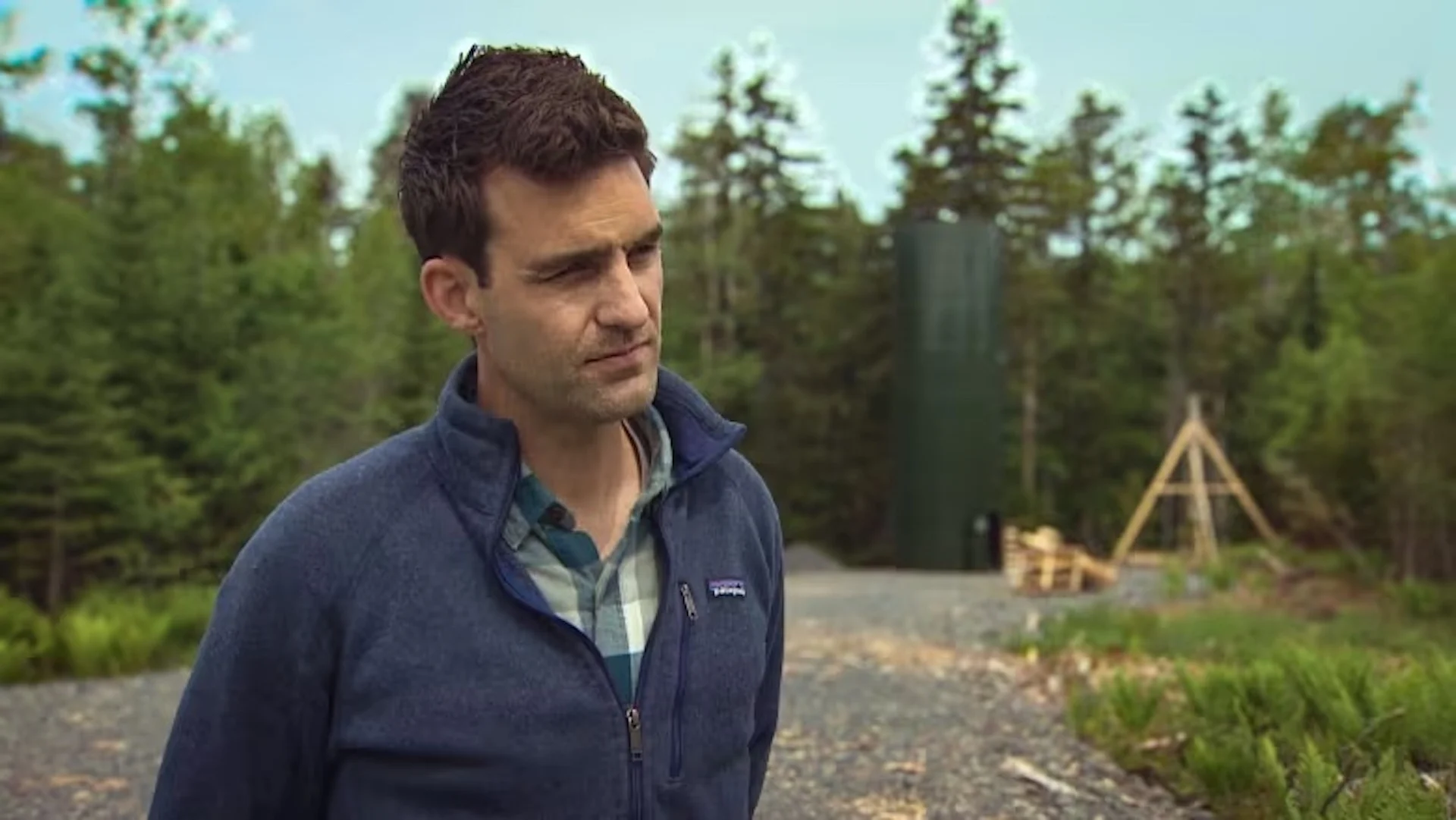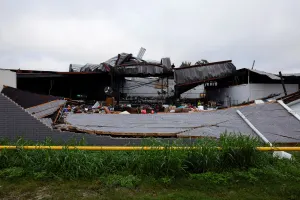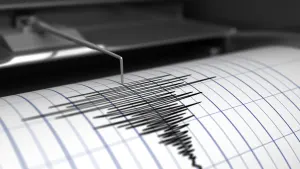
Nova Scotia rivers still suffer from acid rain. Restoration may also aid climate
On the shore of a narrow river in Pictou County, research scientist and CarbonRun chief technical officer Eddie Halfyard inspects the interior of a silo that towers over the forest.
This river, like many others throughout the region, continues to suffer from the effects of acid rain.
"That has huge implications on fish health," says Halfyard.
SEE ALSO: Answer to high ocean acidity may lie in carbon transfer from wetlands
But starting this summer, the Halifax-based startup will be adding powdered limestone from this silo to the river — part of a strategy that the founders of CarbonRun hope will help restore Nova Scotia's salmon rivers while simultaneously removing carbon dioxide from the atmosphere.
"In many cases, it's absolutely restorative," says Halfyard. "We're just replacing what was lost because of human pollution, and that allows rivers to do what they do best, which is to capture carbon and deliver it to the ocean."
Acid rain a persistent problem in Nova Scotia
Acid rain, which is caused when pollutants such as nitrogen oxide and sulfur dioxide infiltrate precipitation, was largely mitigated by the passage of the U.S. Clean Air Act in 1990, and by the 1991 U.S.-Canada Air Quality Agreement.
But in Nova Scotia rivers, the problem never truly went away.
By the time acid rain was addressed, the province's water bodies had been heavily affected by emissions from the burning of coal in central Canada and the northeastern United States. The province's particular geology — where rock is mostly granite — and thin soil means those acid pollutants have not been neutralized by the environment; this, combined with the volume of pollutants that fell here, has made Nova Scotia particularly vulnerable to the effects of acid rain.

Shannon Sterling is one of the co-founders of CarbonRun. (CBC)
"Our rocks are very old here, and they take hundreds of years to regenerate the alkalinity that was stripped out by acid rain," says Shannon Sterling, associate professor in the department of earth and environmental sciences at Dalhousie University and one of CarbonRun's co-founders.
In Nova Scotia, this has created an intractable problem. Some rivers have not seen improvements in water quality in decades. That's had devastating effects on Atlantic salmon, since more acidic water makes it harder for fish to breathe and circulate blood, decreases availability of prey, and increases the concentration of aluminum in a form that's toxic to them.
But in 2016, Sterling learned about attempts to remove carbon dioxide from the atmosphere by adding alkaline material to the soil, and a light bulb went off.
"I was like, 'well, we're already doing that.'"
Since 2005, scientists had been adding limestone to the West River in Sheet Harbour, to reduce acidity and restore the river for salmon; in 2016, the Nova Scotia Salmon Federation also started using helicopters to spread limestone over the forest to increase soil alkalinity.

A helicopter drops limestone over the forest as part of the Nova Scotia Salmon Association's work with the province to boost the pH level of forest soils. (Nova Scotia Salmon Association)
Those efforts had boosted the wild salmon population, but scientists had struggled to find the funding to expand those efforts to more rivers throughout the region.
"There's really no avenue to fund that sort of magnitude of work," Halfyard says.
Removing carbon dioxide represented a new way to cover the costs, while also making a positive impact on the climate.
Adding alkaline material to rivers — which studies suggest already absorb billions of tonnes of carbon dioxide every year — renders them less acidic, which in turn increases their ability to absorb more carbon dioxide from the atmosphere.
In the water, that carbon dioxide shifts to a relatively stable form called bicarbonate, which rivers then transport to the ocean, where it can stay locked away for tens of thousands of years.
Sterling says the point at which this happens — a change in pH level from 5 to 6.5 or 7, or from more acidic to neutral — is also the change needed to render rivers hospitable for fish.

Stephen Likely is CarbonRun's head of process. (Paul Poirier/CBC)
"The only way to protect salmon from acidification is to add the alkalinity back, so that, if done in the right way, can also capture CO2."
In Nova Scotia, the emergence of the voluntary offset market — where companies can purchase carbon removal credits — has facilitated this work. CarbonRun has received a pre-purchase of carbon credits (essentially, a promise to issue carbon credits once the project is up and running) from Frontier Climate, which was launched in 2022 by a group of companies — including Alphabet, Meta and Shopify — to fund the development of climate-related technologies and to facilitate carbon-offset sales.
With that funding, CarbonRun is launching what it says is the world's first carbon removal project via enhancing river alkalinity, and it's set to begin in the coming months.
Stephen Likely, head of process for CarbonRun, says that involves diverting a small portion of the river's flow into the silo, mixing it with the alkaline material and then releasing it back into the water.
"We're continuously monitoring a lot of different qualities of the water, and as a result of that we're able to tune how we're dosing this alkaline material and listen to the river."
Sensors along the river, and at the river's mouth, will also measure whether the dosing is having the effect scientists anticipate.
WATCH: Why these rivers in Alaska have turned bright orange
Likely says scaling this up could involve single dosers on a river, as is the case in Pictou, or multiple silos. At the planetary scale, CarbonRun scientists estimate there are seven hot spots where rivers lack alkalinity. They believe their approach could be scaled up to the gigaton level to address them (a gigaton is a billion tonnes; annual carbon emissions worldwide currently sit around 35 billion tonnes).
Getting there will require testing, including in Pictou County, to ensure that the approach is having the intended effect on ecosystem health and carbon removal.
"This is really only suitable for some rivers, not all rivers, and it's important that the science is there to back up that it is indeed safe, or better yet, beneficial," says Halfyard.
Ultimately, Halfyard says when it comes to carbon removal, there's no replacement for reducing emissions. "That should be the focus."
But for emissions that are hard to reduce, including those from trucking and aviation, removing carbon by making rivers more alkaline may be a tool to help countries reach net zero.
And given the success of past work to address acid rain — salmon production tripled on the West River after the liming project started there in 2005, for example — using this approach means doing the right thing for local ecosystems can have a positive impact on the planet.
"We don't have to fight ecological health in the name of trying to maximize the carbon benefit," says Halfyard.
"I think if we get out of the way of nature and start to remove some of the barriers that we as humans put in their way, it's remarkable how they do rebound."
WATCH: Wetlands could hold the key to carbon sequestration in our oceans
Thumbnail courtesy of Paul Poirier/CBC.
The story was originally written by Moira Donovan and published for CBC News.










